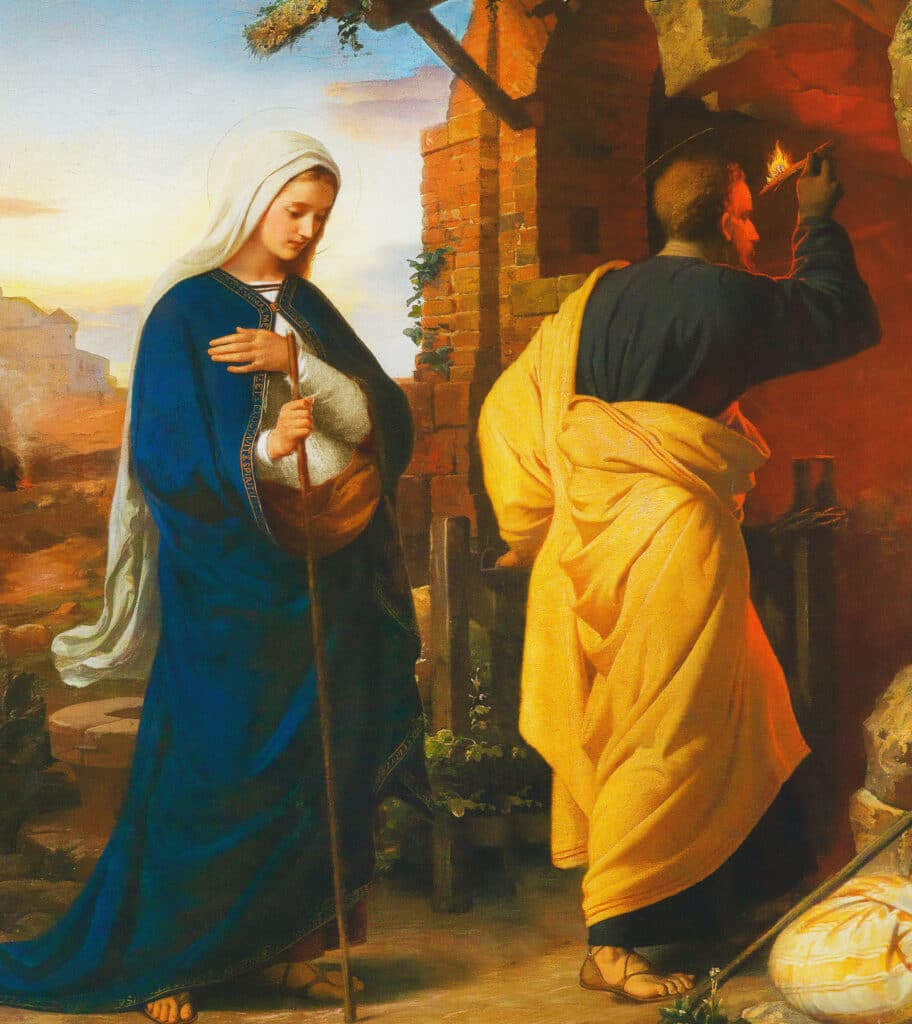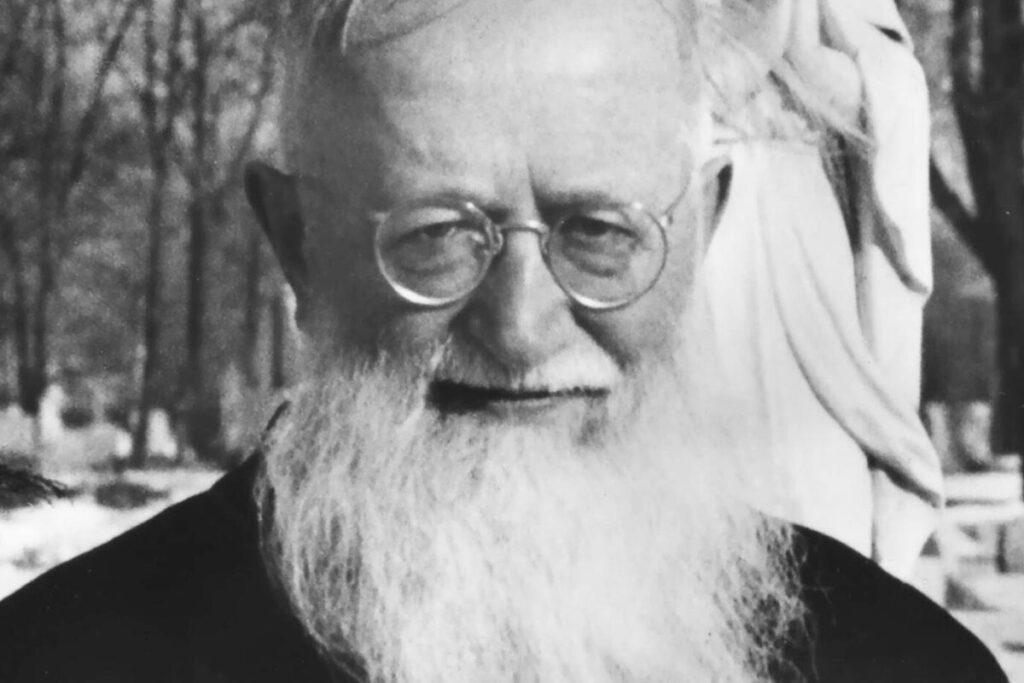A Christmas image
I would like to begin my contribution with a Christmas image. St. Joseph is usually seen either seeking shelter or already in the stable after the birth of the child, adoring or sleeping, that is, attentive to dreams, to God’s instructions.
But an image where St. Joseph peers into the stable with a burning piece of wood and wonders and reflects: is this the place where my Mary can give birth to her child? – I have yet to find a depiction like this one. At the bottom right you see his “knapsack”. I imagine that he has brought the diapers and everything necessary for the child. Thus, Joseph participates actively and fully in the birth in Bethlehem.

Mary says to her son: “Your father”
Then I looked at St. Joseph’s foot. For me as a Swiss, these sandals are not exactly walking shoes. But it is a beautifully shaped foot. This Joseph, he could walk! He had to walk to Bethlehem and then on the flight to Egypt. How many times would he have illuminated a stable or another inn with the light of a burning piece of wood? How many times would he have searched, asked: Where can we find shelter? Thus St. Joseph’s journey continued.
And the last thing that is spoken of him explicitly in the Bible is with the twelve-year-old boy in the Temple. The mother says to her son: “Child, how could you do this to us? Your father and I were looking for you in anguish” (Luke 2:48). For me it is always very touching the way Mary says to her son: “Your father”, and she is referring to St. Joseph, who is not the biological father, but who accompanied them constantly, guided them, took care of them, and who really fulfilled the role of Jesus’ father!
Thus, he lived and fulfilled his mission, his paternal mission. And at that moment, in the temple, Jesus, at the age of twelve, took the initiative: “Why were you looking for me, did you not know that I must be with my Father? (Luke 2:49). He lifts the curtain, so to speak, now, not only at his death, for this new dimension of the Father that he has to reveal. That is Jesus’ mission. And Joseph has thus fulfilled his mission.
Father Kentenich’s mission in the reflection of this image
I believe that this Christmas image says a lot about our Father and Founder. Very briefly I would like to look at the four milestones of our Schoenstatt history and Father Kentenich’s mission in this history from the perspective of this image.
The light shining in the abandoned chapel
Isn’t it the first milestone, October 18, 1914, like Father Kentenich illuminating the abandoned chapel in the old cemetery with his light while he is on his quest? Is this the place where Mary wants to establish herself, where she can act? And he reveals this to the students and puts the words of the Founding Document on Mary’s lips: “First prove to me that you really love me. Then I will gladly dwell among you” – here, in this hidden place, in this little chapel in the old cemetery. A school of love has been opened here. He learned from her, from Mary, how to love, and now they begin this school of love together in the Shrine. This was followed by the careful cultivation of the emerging life in the hearts of the students, the countless correspondence during the First World War, and then, a steady growth eventually reaching the breadth and width of a flourishing movement.

And then, the second milestone: once again discerning what God wants in this new situation. Fr. Kentenich waited and tried until 1935: We must build a stronghold against National Socialism, build a broad pilgrim movement. But then he realized that National Socialism was going to sweep through Germany. He realizes: We must ensure survival, strengthen the roots! We must secure the school of love by renewing the consecration to the Blessed Mother, deepen our love by following the cross!
The illumination on Father’s face
What I especially like about our Christmas image is that when St. Joseph illuminates the stable, his own face is also illuminated. In seeking God’s will, our Father’s face is illuminated for the Family, and his own role in the Family is enlightened for him according to God’s mysterious plan of love. Such a diversely structured movement needs a personal central figure. The close bond with him becomes paramount in the struggle for January 20th, in the striving for his release, in the prayers for a Christmas Eve miracle. From then on, a light shone on the face of St. Joseph and now on the face of our Founder as a father figure.
The Wall
And then the release from Dachau: towards the third milestone. The new divine reassurance that our Father experienced in Dachau, how God not only preserved him, but also blessed Schoenstatt, led to a fundamental decision: We can no longer keep the gift of Schoenstatt to ourselves, we must take it to the whole world. So now we must go out into the wide world, establish Shrines, and bring Schoenstatt before the ecclesiastical authorities, to the Church! But there was disagreement and eventually rejection. In the letter of May 31, 1949, he spoke of a wall made of mechanistic thinking that blocked Mary’s work, the development of her school of love from the Shrine.
Here, in the Christmas image, we see this wall near the stable: I see it as a symbol of this wall in front of which the Blessed Mother now finds herself. Therefore: we must strengthen the school of love under the sign of the cross as we struggle for the mission of organic thinking, living, and loving. And the harsh consequence is the Founder’s exile. The Bishops, Father Tromp, and the Holy See. In fact, the opposite happened in Milwaukee: It was precisely because of the exile that Father Kentenich was brought back to the center as a father.
A “Christmas Eve Miracle” on December 24, 1965
Then, the fourth milestone: his return home! Audience with the Holy Father, Christmas Eve Miracle of December 24, 1965! We look at the image of our Father in the Original Shrine: what must have gone through his soul after these long years of a history full of developments, starting with the first glance at the chapel in the old cemetery with the question: “Is this the place for the Blessed Mother’s mission?” So many difficult struggles, so much heroism through faith up to this Christmas Eve miracle! The illumination of this holy history in the face of our Father and Founder! Yes, this is how we lived it, and this is how I came to know him: in his talks, not so much in personal encounters, but in the great lectures and retreats.
The article continues. The second part will be published shortly.
Translation: Maribel Acaron
